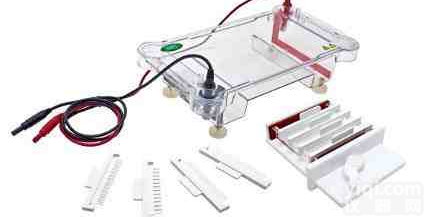PRODUCT DESCRIPTION - APPLICATIONS:
Agarose is a purified linear galactan hydrocolloid isolated from agar or agar-bearing marine algae. Structurally, it is a linear polymer consisting of alternating D-galactose and 3,6-anhydro-L-galactose units. As a gelling agent, agarose is used: 1.) to separate nucleic acids electrophoretically because its gels have larger pore sizes than polyacrylamide gels at low concentrations. Unlike polyacrylamide, the consistency of the gels is more solid (but also less elastic); 2.) To demonstrate cross reaction in IEP (Immuno electrophoresis) and Ouchterlony (double diffusion) plates in which antibody-antigen precipitin lines are studied; 3.) to make gel plates or overlays for cells in tissue culture. 4.) To form a gel matrix (either beaded and/or crosslinked) which can be used in chromatographic separations.
PROPERTIES OF AGAROSES OFFERED BY SIGMA:
Please refer to the table on pages 4-8.
Sulfate content may be used as an indicator of purity, since sulfate is the major ionic group present.
Gel strength is the force that must be applied to a gel to cause it to fracture.
The gel point is the temperature at which an aqueous agarose solution forms a gel as it cools. Agarose solutions exhibit hysteresis in the liquid-to-gel transition - that is, their gel point is not the same as their melting temperature.
AGAROSE
PROPERTIES OF AGAROSES OFFERED BY SIGMA: (continued)
Anionic groups in an agarose gel are affixed to the matrix and cannot move, but dissociable cations can migrate toward the cathode in the electrophoresis unit, giving rise to electroendosmosis (EEO) – a movement of liquid through the gel. Since electrophoretic movement of biopolymers is usually toward the anode, EEO can disrupt separations because of internal convection.
USAGE INSTRUCTIONS FOR MAKING GELS:
Boiling water bath method:
a. Add any buffer of choice (usually with an ionic strength, m,2 of 0.03-0.10) and a stir bar to a beaker which can hold 2-4 times the volume of the desired solution.3
b. Slowly sprinkle the agarose powder into the liquid while stirring to prevent clumping.
c. Weigh the beaker and solution before heating.
d. Cover the beaker with plastic wrap and pierce a hole in the wrap for ventilation.
e. Bring the solution to a boil and allow it to boil for 5-10 minutes stirring continuously, until agarose dissolves completely. To avoid charring, use a boiling water bath rather than directly applied heat.3
f. Add enough hot distilled water to return the contents to the original weight; mix continuously.
g. Allow the mixture to cool to 50-55°C, at which temperature it is ready to be cast into cassettes which have been pre-warmed to 50-55°C.3
Microwave method 1 (for gels £2% w/v):
a. Add any buffer of choice (usually with an ionic strength, m,2 of 0.03-0.10) and a stir bar to a beaker which can hold 2-4 times the volume of the desired solution.3
b. Slowly sprinkle the agarose powder into the liquid while stirring to prevent clumping.
c. Remove the stir bar.
d. Weigh the beaker and solution before heating.
e. Cover the beaker with plastic wrap and pierce a hole in the wrap for ventilation.
f. Place the solution in a microwave oven and heat on HIGH power for 2 minutes.
g. Remove the solution from the oven very carefully; any microwaved solution may be superheated and could foam over the container's rim if agitated. Swirl gently to re-suspend any remaining agarose
particles.
h. Reheat on HIGH power for 1-2 minutes or until the solution comes to a boil. Boil for 1 more minute or until the solution is clear and the agarose is completely dissolved.
i. Remove the solution from the oven very carefully and swirl it gently.
j. Add enough hot distilled water to return the contents to the original weight; mix continuously.
k. Allow the mixture to cool to 50-55°C, at which temperature it is ready to be cast into cassettes which have been prewarmed to 50-55°C.
AGAROSE
Microwave method 2 (for gels >2% w/v):
Follow the same protocol as for £2% gels (above), but use a MEDIUM instead of HIGH power setting in step
f.
OTHER GELLING AGENTS:
1. Agar: Separate data sheet is available.
2. Gelatin: Separate data sheet is available.
3. Phytagel (Sigma product number P8169): Phytagel is an agar substitute produced from a bacterial carbohydrate composed of glucuronic acid, rhamnose and glucose. It produces a clear, colorless, high strength gel which aids in detection of microbial contamination. Phytagel provides an economical alternative to agar as a gelling agent (agar contain about 70% agarose). Originally developed for microbial applications, Phytagel is a good choice in any application (such as plant cell culture) where some agar products tend to inhibit growth due to unidentified impurities. To prevent clumping, Phytagel should be added to culture medium that is at room temperature, with rapid stirring.
4. Agargel (Sigma product number A3301): Agargel is a blend of agar and Phytagel which was developed to help control vitrification in plant tissue cultures. Agargel provides the positive attributes of agar and Phytagel, is cheaper than agar, and is superior to Phytagel in applications where vitrification is a problem. Agargel produces a semiclear gel which allows for better detection of contamination.
| 货号 | 名称 | 英文名称 | 规格 | 单价 |
| Sigma-A9539 | 琼脂糖 (常规电泳级) | Agarose (electrophoresis grade) | 10G | 456 |
| Sigma-A4679 | 琼脂糖 (免疫学电泳级) | Agarose (for immunoelectrophoresis) | 25G | 926 |
温馨提示:不可用于临床ZL。
 Agarose (electrophoresis grade) 琼脂糖 (常规电泳级)
Agarose (electrophoresis grade) 琼脂糖 (常规电泳级)
 10×碱性琼脂糖电泳缓冲液价格10×Alkaline Agarose Gel Electrophoresis Buffer
10×碱性琼脂糖电泳缓冲液价格10×Alkaline Agarose Gel Electrophoresis Buffer
 DL19- DYCP-32A 琼脂糖水平电泳仪 中号琼脂糖电泳仪 DNA电泳仪
DL19- DYCP-32A 琼脂糖水平电泳仪 中号琼脂糖电泳仪 DNA电泳仪
 琼脂糖水平电泳仪 中号琼脂糖电泳仪 DNA电泳仪
琼脂糖水平电泳仪 中号琼脂糖电泳仪 DNA电泳仪
 DYCP-31C型琼脂糖水平电泳槽|微琼脂糖电泳仪市场报价|水平电泳仪(槽)厂家
DYCP-31C型琼脂糖水平电泳槽|微琼脂糖电泳仪市场报价|水平电泳仪(槽)厂家
 琼脂糖电泳仪电源,琼脂糖电泳仪电源批发
琼脂糖电泳仪电源,琼脂糖电泳仪电源批发
 DL19- DYCP-31C 琼脂糖电泳仪 DNA琼脂糖电电泳仪
DL19- DYCP-31C 琼脂糖电泳仪 DNA琼脂糖电电泳仪
 琼脂糖电泳仪 DNA琼脂糖电电泳仪
琼脂糖电泳仪 DNA琼脂糖电电泳仪
 琼脂糖电泳仪, DNA琼脂糖电电泳仪
琼脂糖电泳仪, DNA琼脂糖电电泳仪
 沈阳琼脂糖电泳仪(槽水平中号) 琼脂糖电泳仪(槽水平中号)厂家原装现货
沈阳琼脂糖电泳仪(槽水平中号) 琼脂糖电泳仪(槽水平中号)厂家原装现货
 琼脂糖水平电泳仪 ,中号琼脂糖电泳仪
琼脂糖水平电泳仪 ,中号琼脂糖电泳仪
 水平电泳槽/核酸电泳槽/琼脂糖电泳槽/DNA电泳槽/PCR电泳槽
水平电泳槽/核酸电泳槽/琼脂糖电泳槽/DNA电泳槽/PCR电泳槽